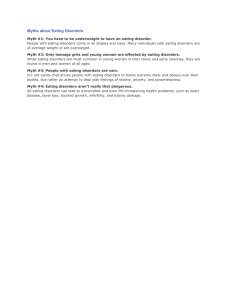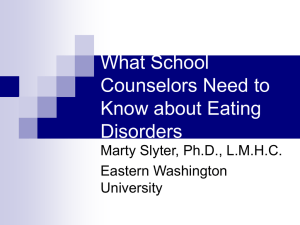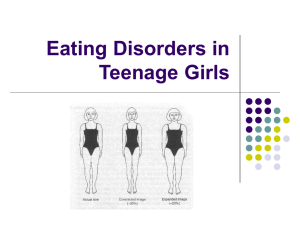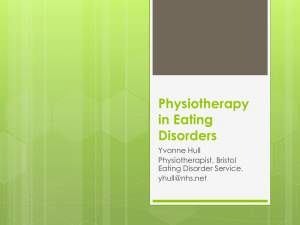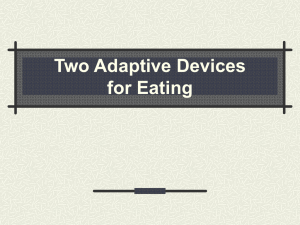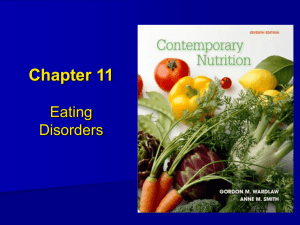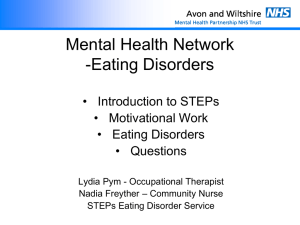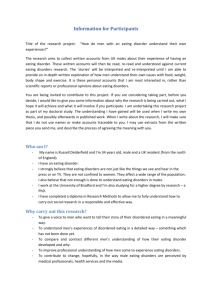Body Image and Eating Disorders
advertisement
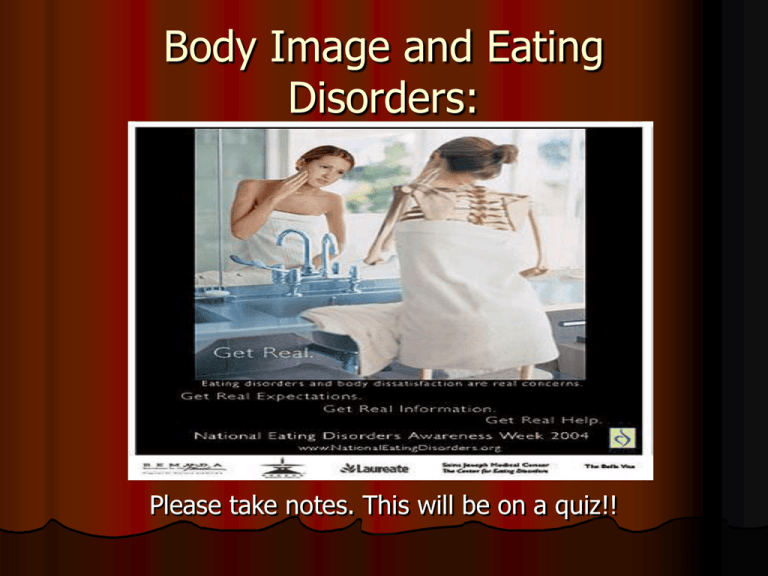
Body Image and Eating Disorders: Please take notes. This will be on a quiz!! Definitions: Anorexia=Fear of gaining weight, see themselves differently than others, starve themselves This leads to loss of period in girls (this is called amenorrhea) Bulimia=Binge and purge Binge eating = Most common. Out of control over eating. Eating when not hungry. Feeling guilty about it later. Muscle dysmorphia= Often seen in men. This Other inappropriate ways to prevent weight gain are: laxatives, fasting, vomiting, diet pills, excessive exercising person thinks they need to be more muscular or more toned and is obsessed with it. They say “I'm not big enough”. In a way the opposite of anorexia. Facts A study in 1995 found that 3 minutes spent looking at models in magazines caused 70% of women to feel depressed There are 3 billion women who don’t look like supermodels and only 8 who do The models in the magazines are Airbrushed…they don’t really look like that! Our bodies are programmed to weigh a certain amount “Genetics loads the gun and environment pulls the trigger” So..If you have a relative with an eating disorder you are 30 times more likely to get one More facts Everybody is born different: different bone structure, different genetics, some more muscular than others, some are more lean. It’s all about BALANCE You can die from an eating disorder! But usually before the eating disorder kills the victim they usually commit suicide. Eating disorders are highly correlated with suicide All eating disorders are connected to: 1.Genetics 2.Obsessive Compulsive Behaviors 3. And other disorders If you need help, please call the hotline: 847-831-3438 all services are FREE OR talk to an adult you trust! Mary Kate is one of many celebrities that struggles with an eating disorder. Do you like that she looks GOOD? What other famous people have struggled? True or False? What do you think? 15-20% of Males have eating disorders 5-10% of middle school girls have eating disorders Middle school students gain 40 lbs during puberty You can be 180lbs and still be fit and healthy Middle school students need proper nutrition since they are growing Skipping meals will help you lose weight Eating low fat foods will help you lose weight The average American women wears a size 12 or 14! The media has a lot to do with our body image Body Image Body Image = Body image is how you see yourself when you look in the mirror or picture yourself in your mind. Negative body image= distorted perception— seeing things that aren't so. People with negative body image are more likely to get an eating disorder and more likely to suffer feelings of depression, low self-esteem, loneliness. Positive body image= celebrate and accept the way your body is perfect or not. Comfortable in your own skin Accept your body-Accept yourself YOUR HOMEWORK: To list at least 5 things you like about your body to be handed in to Ms.B next class. To review: It all about: Self esteem, good body image, balance What is amenorrhea? How much does a middle school student usually gain during puberty? Is looking at magazines good for your body image? Do boys also have eating disorders? What are eating disorders highly correlated/related to? What is your homework? To List at least 3 good things you like about your body bring into class next class



